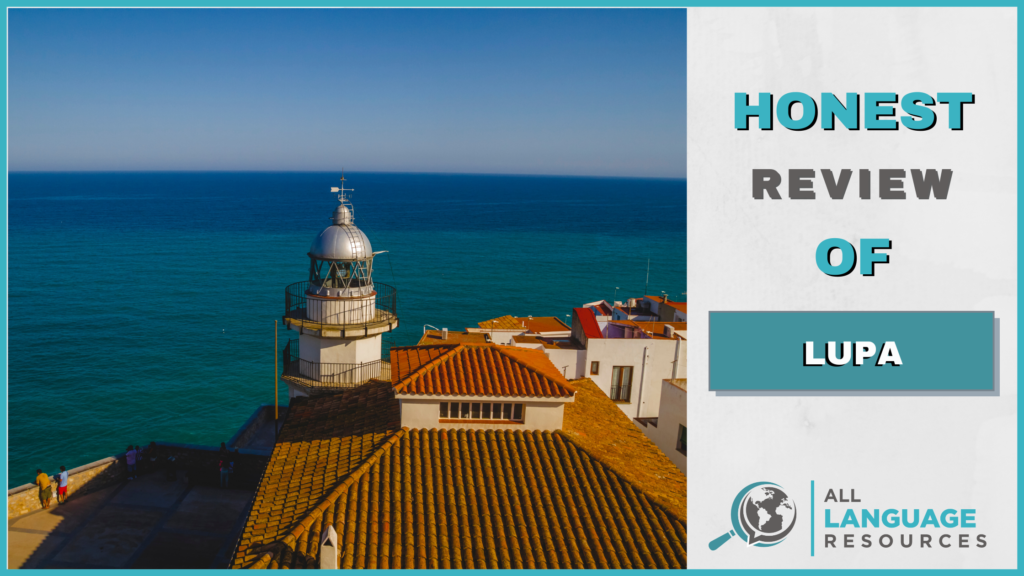Jiveworld (Lupa)

Summary
Jiveworld (previously Lupa) is a podcast-style app that helps Latin American Spanish learners improve their listening comprehension. The company has partnered with NPR’s Radio Ambulante to republish fascinating stories and interviews full of cultural insights and natural Spanish. Then, they have added a bunch of learner-friendly features to help you understand what’s being said: variable speeds, partial transcripts and translations, definitions and more. The stories are what shine here. They represent diverse communities around Latin America, and the recordings are high quality. Most of our testers found their listening comprehension markedly improved after just a couple of weeks. However, Lupa could benefit from additional features, such as review activities, interactive quizzes and learner pathways. It’s also not suited to beginners, while lower-intermediate learners may struggle.
NOTE: LUPA IS NOW JIVEWORLD. WE UNDERSTAND THE APP HAS BEEN TOTALLY REDESIGNED AND IMPROVED, BUT HAVE NOT YET HAD OPPORTUNITY TO TEST IT OUT. This review applies to the old Lupa.
The quality is generally excellent, although the app is difficult to use with a screen reader.
Lupa’s stories are fascinating, if at times heavy-going, but there are no learning pathways and testers struggled to remember vocabulary.
Users found it to be an excellent use of their time but were divided over whether they would pay the subscription rate.
I Like
- They noticed an improvement in their listening comprehension after one or two weeks.
- Fascinating stories full of cultural insights.
- Plenty to challenge even advanced learners.
- Wide range of Latin American Spanish dialects and communities.
I Don’t Like
- The vocab feature is extremely basic.
- No interactive or review activities.
- The material can be challenging.
- Limited light-hearted stories.
Price
$12/month zero-commitment or $99/year charged in one lump sum
By signing up via the link below, the cost is $10/month or $84/year.
NOTE: LUPA IS NOW JIVEWORLD. WE UNDERSTAND THE APP HAS BEEN TOTALLY REDESIGNED AND IMPROVED, BUT HAVE NOT YET HAD OPPORTUNITY TO TEST IT OUT. The review applies to the old Lupa.
Listening comprehension is one of the trickiest things to improve as a learner. And the better you get at speaking Spanish, the more likely it is that the person you’re talking with will start using local slang and natural phrasing, like
hacer locha (laze about) or revolú (mess).
NOTE: LUPA IS NOW JIVEWORLD. WE UNDERSTAND THE APP HAS BEEN TOTALLY REDESIGNED AND IMPROVED, BUT HAVE NOT YET HAD OPPORTUNITY TO TEST IT OUT. This review applies to the old Lupa.
Enter Lupa, the app designed to improve your listening, give you cultural insights and teach you natural phrases that native speakers really use. You’ll hear “hacer locha” in the episode “No soy tu chiste”, “revolú” in “Juegos de niños”, and lots more in the app’s 100+ stories.
But did it live up to expectations when tested by real Spanish learners? Let’s find out.
How We Tested and Scored Lupa
This is one of our user-tested reviews, which means it was tried and tested by a randomly selected group of 11 intermediate- and advanced-level Spanish learners from our user reviewer database.
The testers tried Lupa out for a period of at least two weeks, during which they periodically filled in surveys about the app: if it offers good value for money, what they like about it, if their listening improved during that period and much more.
At the end of the review period, we entered all the answers to quantitative, numerical questions into our algorithm to get the value, content, quality and overall scores above. (In case you’re wondering how we came up with that algorithm, it’s based on our experiences of reviewing hundreds of resources, as well as studying and teaching languages. And then, we tested it on courses and apps to make sure the scores it produced were fair and accurate.)
Finally, we used Lupa’s scores and the testers’ responses to the qualitative questions to write up this review. And of course, we also tried out Lupa ourselves so we know how it works. Although our personal opinion hasn’t influenced this review at all, we do this to make sure we can write about the resource accurately.
So, now that you know how we reviewed Lupa, let’s take a look at the app. We’ll explore how it works, if it’s effective and interesting, what levels it’s suited to and if it offers value for money.
[the_ad id=”28623″]How to Use Lupa
You can sign up for Lupa online or via the app, but the actual resource is only available via the app. The download and signup process is straightforward.
After downloading it and signing in, you’ll be able to view recommended stories or all stories listed by country, topic, duration or original air date. They range from 5 to 35 minutes in length, so it shouldn’t be too tricky to find one that you have enough time for.
Bear in mind that you won’t be able to find stories ordered by difficulty level. One user said that they would have appreciated “a learner’s track”, explaining that “the first one I clicked on had a really strong accent – I was nowhere near ear-trained enough to get it.”
When browsing by topic, there’s a wide range of alphabetically ordered themes, such as conflict, LGBTQI+, literature, migration, food, music, racism, women’s rights, work, politics, sports and more. There isn’t a drop-down or collapsible menu for the topics, so you have to scroll past all the themes and stories until you find the one that interests you. This can be unwieldy; one tester mentioned that “the long list of stories is a little overwhelming to scroll through.”
Once you’ve chosen and clicked on a story, you’ll see an English-language blurb. If it interests you, then you need to download the story. From there, the story will be split into short chapters that are just a couple of minutes long. Click “Begin chapter” to start.
This is when Lupa really begins to offer something more for users than just access to the free Radio Ambulante episodes. If the story features a more challenging accent or non-standard Spanish, it will start off with some notes to help you make sense of it.
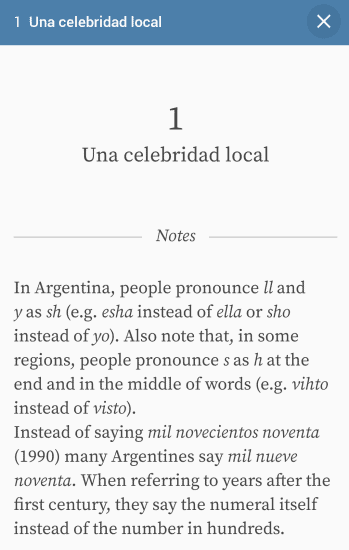
Once you’ve pressed play, you can choose how much help you receive from the transcripts and translations. You can opt to listen without a transcript, with key Spanish vocabulary showing from the transcript or while simultaneously reading the English translation of the transcript.
If you choose to see some key vocabulary, you can also adjust how much you want to see. The options are vocabulary, mistakes made by the interviewees, and “tricky bits”. You can also choose to see “passage hints” at the top of the screen, which will tell you in English what’s being discussed. For example, it might say “some of Sandra’s characteristics”.
Regardless of the transcript you choose – even if it’s the blurred-out “no transcript” option – it will automatically scroll so that you can see where you are in the story.
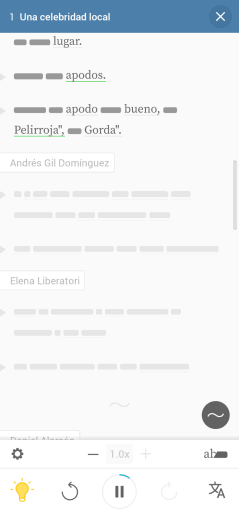
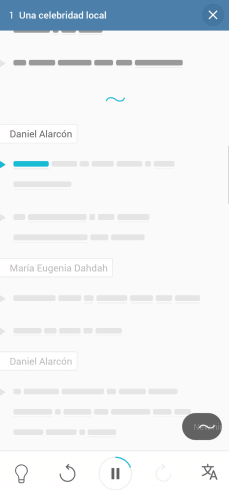
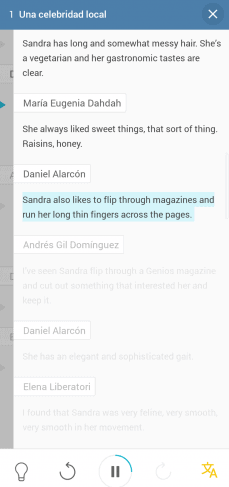
You can also vary the speed and click on underlined words and phrases to see the definition. Unless it’s an example of incorrect Spanish, doing this adds the vocabulary to your vocab bank. You can remove it from there without having to leave the story.
However, regardless of how much of the transcript you’ve chosen to see, you cannot click on a word that isn’t underlined. If you don’t understand it, you have to try to work it out from the context. One user wrote, “I really wanted to be able to click on any words, not just the ones they thought I wouldn’t know.”
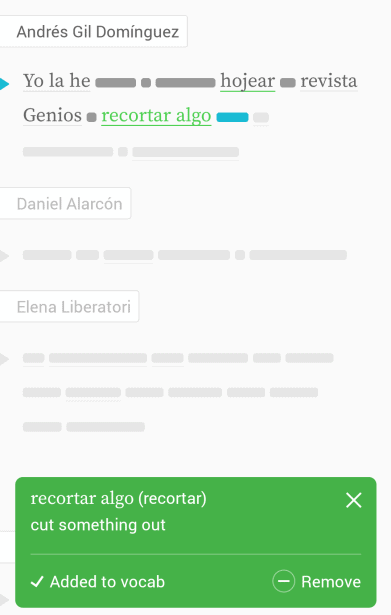
You’re encouraged to listen to each story twice, the second time without the transcript. You can also export your vocab bank, i.e. receive an email with files that can then be imported into apps like Anki and Quizlet.
Once you’ve finished listening to the story, you can mark it as complete and select a new one to listen to. You also gain stars for the number of minutes you spend listening and re-listening to stories, although they don’t seem to serve any purpose beyond making you feel good about your studies.
Is Lupa Easy to Use and Accessible?
Lupa scored an average of 4 out of 5 for being user-friendly, but it’s not all good news, especially when it comes to accessibility.
Lupa has a lot of options designed to help you choose exactly how difficult you want your listening task to be. As such, it can take a few minutes to work out how to toggle them all on and off – to the point that one user described it as “cumbersome”.
Most users agreed that the tutorials helped them, so check out the Studying With Lupa section if you feel lost. As one said, “I was confused about all the functions at first, but I was able to figure them out quickly, and you can easily find a description on the app’s website which is also linked in the app.”
Disappointingly, though, one tester reported that Lupa isn’t as accessible for visually impaired learners and other users of screen readers as it could be. “I am blind and the app isn’t easy to navigate with a screen reader,” they said, adding that “there are no clear paths to follow.”
Another wrote, “I would like to have a desktop version. Because of my rheumatoid arthritis I have difficulty with my fingers and find cellphones challenging to operate.”
Hopefully, Lupa will improve the app’s accessibility in the future. But for now, users with screen readers or who struggle with phones should take that into account when deciding whether or not to subscribe. We recommend making good use of the free trial before committing so that you know exactly how challenging it will be.
Lupa’s Stories: Are They Interesting & Relevant?
Time and again, testers praised the stories as “interesting”, “relevant”, and covering diverse topics. In many cases, they were their favourite thing about Lupa. One said, “[They] are by far the best part. They are so engaging!”. Another wrote, “It’s fun, and I learn. Win-win.”
They also give valuable cultural insights. One tester called them “a true window into the countries of Latin America,” while another said, “I really had little idea of the existence of black Colombians. Or reaffirmation of the presence of Korean Argentines. And… about mate and milonguear. Language and cultural insights are inextricably interwoven.”
However, Lupa’s stories aren’t for everyone. Another tester described them as “heavy”, and lacking “humorous” and “cheerful” ones. They said, “I’d like light-hearted stories. My biggest reason for not using the resource as often as I wanted to was because I knew I was going to have to read a story I wouldn’t particularly enjoy because they’re all so serious.”
If you’re looking for something that’s more El ministerio del tiempo than Ya no estoy aquí, you might struggle to find as many stories to your liking. Many interviewees narrate traumatic experiences, which can make for intense listening. Some episodes start with Spanish-language warnings of graphic descriptions of violence and sexual abuse, but the English-language descriptions do not always mention this.
However, if you’re interested in deep dives and inclusive human-interest stories, you’ll probably find plenty of interesting and thought-provoking pieces among Lupa’s content.
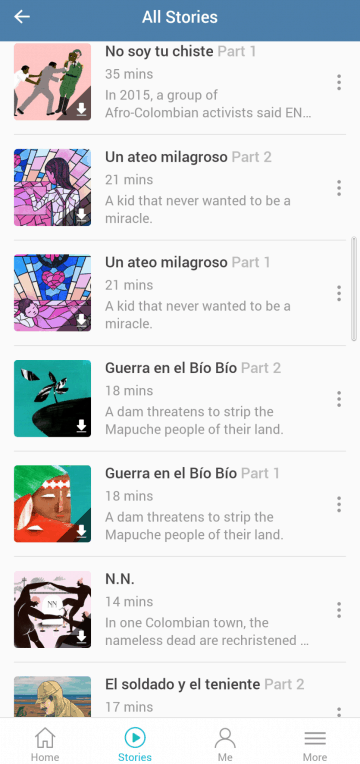
Does Lupa Have Content for All Spanish Dialects?
Lupa currently features stories from 15 different Latin American countries, as well as from members of the Latin American diaspora. One user, despite generally not liking Lupa’s content, said, “It’s super useful because it’s done by place, which is interesting and unique as far as language apps go – you often just pick between Spain and ‘Latin America’ as though it’s all the same in Latin America.”
But not all countries are currently equally represented. Another found that, “At the moment the stories are a little tilted towards a few countries. Some have few contributions (e.g. Bolivia), others are absent (e.g. Paraguay, Uruguay).”
Argentina, Chile, Colombia, Mexico, Pero, Puerto Rico, Brazil, United States: these are some of the countries with the most stories. Others, such as Guatemala and Honduras, only have a couple of stories each at the time of this article’s publication. However, this may change as more episodes are published.
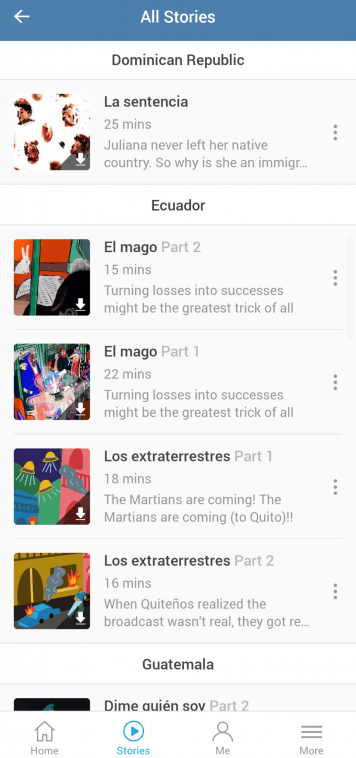
It’s also worth stressing that Lupa is focused on Latin America. One user was disappointed by the lack of Spain-related content along with Castilian Spanish accents and dialects. Although there is at least one Spanish journalist featured in Lupa, it’s not possible to search by the journalists’ names.
It can be hard to find resources that cater for both European and Latin American Spanish. But if you want to learn Spanish as it’s spoken in Spain, scroll down to the end of this article. We’ve listed some recommendations for you.
Will Lupa Improve Your Spanish?
We asked Lupa what we could expect to improve or gain through using the app, and they told us that learners would improve their listening comprehension, learn slang/natural phrases and gain cultural insights.
So what did our testers think? Well, they gave it 4.1 out of 5 for listening, 3.8 out of 5 for slang/natural phrases and 4.4 out of 5 for cultural insights. The last score should come as no surprise, given how informative and interesting most users found the stories to be. But let’s take a look at the other two in more detail.
Our testers scored Lupa over the course of two weeks, and 90% of them used it either every day, most days or every other day. Nearly all of them reported noticing an improvement in their listening comprehension.
One said, “Listening comprehension is so incredibly difficult for me, and I’m actually getting better! This is semi-miraculous. I am an older learner (60-ish), I have life-long auditory processing difficulties (which impact my listening comprehension even in English, my native language), and I have a serious chronic health issue that comes with massive fatigue and brain fog. So I’m never going to be good at this. But this is giving me a start. A really good start.”
They added, “The sense of accomplishment is tremendously gratifying… every time that I listen to a story at speed and actually hear/understand the words spoken, it feels like a tremendous achievement.”
Some reported that it wasn’t just the extra exposure to Spanish audio that helped them improve, but also the range of speakers and Lupa’s extra features. One said, “I love the various adjustments that can be made to the settings. On the – for me – more difficult presentations, I could work my way up to speed. To hear a variety of voices is also a boon.”
Another described Lupa as “hugely helpful” for listening comprehension, explaining how they adjust the audio speed, increasing it over time, and also use the transcript tools to challenge their listening. “I love how you can cover up the transcript and just ‘click’ for tricky words that you miss,” they said, “so you’re not focused on reading but you still get the full story.”
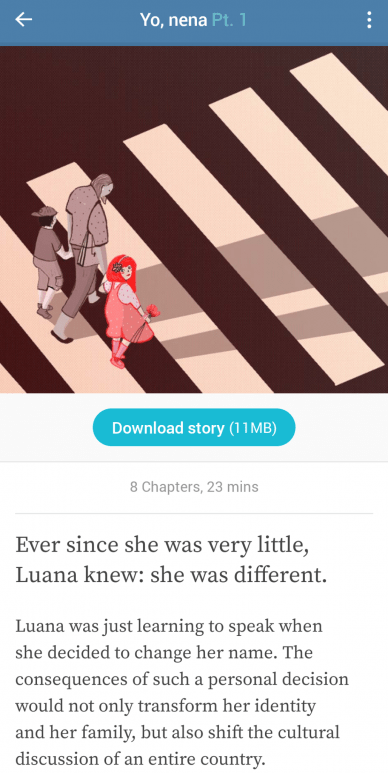
Lupa definitely introduces you to plenty of slang and natural phrases, but whether or not it teaches you them is another matter.
One user said, “There are so many pieces of slang in each story, it’s sort of info overload; I would have to use another system to supplement to memorize all of those… You just get 30 new phrases and 30 more in the next story and so on. Because it’s so much, I don’t know if I could actually use any of the phrases I heard.”
They felt that if Lupa had learner pathways that introduced you to a series of stories using the same slang, they might have remembered them better.
Another reported remembering the phrases – but it was because they listened to each story multiple times. “There are native speakers talking all the time so the material is full of phrases and slang which is explained and translated in the resource so you can learn. And because I listen to each section several times I am actually starting to recognize some phrases.”
And another tester had a more balanced perspective. “Some natural phrases – that I didn’t get from formal learning resources – crop up all the time, across multiple stories. Those have been easy to absorb, and give a very pleasing sense of familiarity with the natural rhythms of the language… However, many of the slang/dialect phrases occur only once in a single story, so they aren’t going to stick with me unless I work at learning them.”
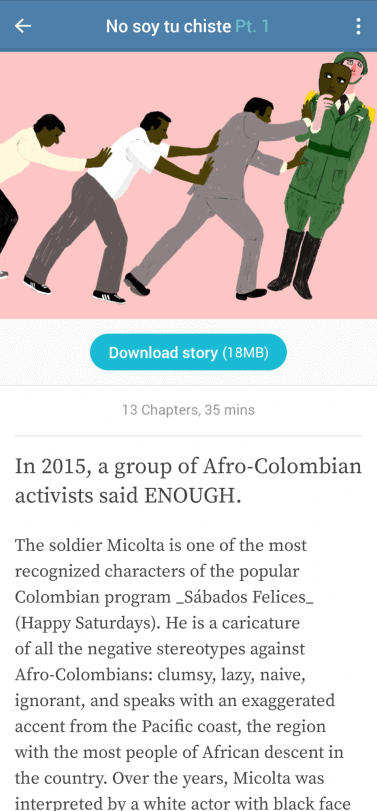
Ultimately, Lupa helps you to understand the stories and improve your listening comprehension, but it has limited review activities. Numerous users mentioned wanting more in-app drilling opportunities for the vocabulary. Other features they would have liked included comprehension quizzes, writing activities based on the story or vocabulary, and a way to save snippets of audio to review later.
How much of an issue this is depends on your goals. If you want to learn lots of vocabulary, you’ll need to use Lupa in tandem with another resource (and we’ll talk about some of those later).
If, however, you’re happy just picking up the odd piece of vocabulary here and there, you might find Lupa works well for that. Since it introduces them in a natural way, you’re more likely to find them meaningful. As one user reported back, “The ‘natural phrases’ also give insight into a people. How was I to know that lechuza isn’t only an owl. Could be a funeral director or a snoop. Wonderful!”
Sign up via the link below to get a discounted price.
What Level Is Lupa Suited To?
Lupa has plenty to teach you, but you’ll always learn best when a resource is targeted at the right difficulty level. Too difficult, and you’ll find yourself demotivated and overly reliant on the translations. Too easy, and you might find it’s not worth your time – although nobody reported finding Lupa too easy.
Most testers agreed that Lupa is well-suited to upper-intermediate and advanced students. One said, “It’s targeted to intermediate and advanced learners, and that’s exactly right. The material is more than half professional ‘radio voices’ which are easier for intermediate learners to parse and understand, and then a mixture of clips of ordinary people speaking with accents from all around the Spanish-speaking world. So there’s stuff to challenge more advanced learners, too.”
Another, however, struggled to find content at the right difficulty level and pointed out that the app’s lack of pathways can make it frustrating. “Perhaps there are easier stories, but the stories aren’t labeled (that I’ve seen) by fluency level,” they said. “They’re only labeled by subject matter.”
One thing is for certain: Lupa has plenty to challenge you. You’ll be exposed to a wide range of native speakers, many of whom have different accents, dialects and backgrounds. As one user said about the interviewees, “[the] mumbling is realistic but can be frustrating.”
You’ll also likely be introduced to new vocabulary. Another tester, who considers themselves an advanced Spanish speaker, wrote, “Content is comprehensible while providing new/unfamiliar words and expressions.”
Even though Lupa can be challenging, it won’t leave you floundering. There are sufficient features that, with a bit of hard work, anyone should be able to follow the story. One user said, “It’s definitely tricky, but with the transcript, adjustable speeds, and translations, it makes it a lot easier.”
You can also start with more familiar accents and move on to ones that offer more of a challenge, although it may take some experimentation at first to work out which accents you find easier.
And despite the difficult content, our testers still enjoyed using Lupa. In fact, they gave it an average of 4.2 out of 5 for how much they were enjoying it, with only one person scoring it lower than 4. And several mentioned that the app’s challenging nature made seeing their progress very rewarding.
In short, Lupa isn’t an easy app, but the dialogues are realistic. Upper-intermediate learners will likely find it a sufficient challenge, with Lupa’s student-friendly features essential to following the story. Advanced users may find the narrators’ voices easy to understand, but they’ll likely discover new phrases, and listening to the interviewees could require some concentration.
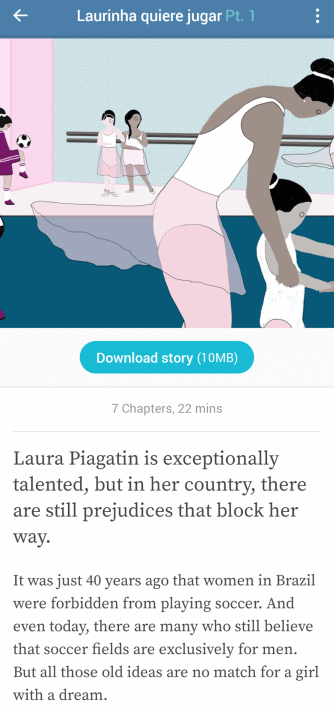
Does Lupa Offer Value for Money?
We define value as being a good use of both your time and money. So, what did our user reviewers make of Lupa?
They gave the app an impressive 4.3 out of 5 for being a good use of their time, but not all of them were convinced by the price. In fact, when asked “how happy would you be to pay for it?”, the average score dropped to 3.2 out of 5.
Before you assume that Lupa is overpriced, however, it’s worth mentioning that this question had one of the biggest median ranges on the survey. In other words, some people were very happy to pay that price – but others weren’t at all.
And despite the price, nearly every user reviewer said they would recommend Lupa. Confused? Let’s unpack the answers a bit more and explore whether Lupa is worth paying for.
The biggest point of contention was whether it was worth paying for a resource that, while high quality, had a very specific focus. One user said, “It’s solely listening, and I would be uncomfortable to pay $12 [the monthly subscription rate] and have to buy other resources to supplement other areas like speaking.”
This was a common refrain. Another user said, “This app is doing an excellent job of teaching listening comprehension, and that is one of the hardest aspects of language learning. So, maximum value-for-dollar if I consider just that single focus. At the same time, it’s only one aspect of the process. It doesn’t address all my language learning needs, and with a limited budget, that means juggling which paid resources I am using at any given time.”
Among those who were willing to pay for it, there were two main groups: those who would prefer the annual plan and those who would sign up for a month at a time. One person said, “I would take the yearly subscription. For the cost of a coffee a week, I am getting a good deal.”
Others, however, preferred the idea of subscribing for just a few months and using it intensively before moving onto a new resource. Among those, a couple of testers were unsure about whether Lupa would continue offering value by the time they’d caught up on previously published stories.
It’s worth mentioning that this is more likely to be an issue if you use it prolifically and only want to listen to stories from certain countries or about certain themes. Lupa has already uploaded over 100 stories and releases a new one every week. If you signed up at the time of this article’s publication, were happy to listen to everything and averaged three new stories a week, you would run out of material after 11.5 months – or effectively, at the end of a year-long subscription.
So, what does this mean for you? Let’s sum it up: Lupa represents good value for money if you’re happy to pay for a resource that’s focused on one skill set. If you want to work on speaking, writing and grammar, you’ll need to use other resources alongside it (and we’ve recommended some complementary resources for this below).
What’s more, advanced learners who don’t need Lupa’s extra features may prefer to just use Radio Ambulante. As one tester said, “You can look at the transcriptions and translations of the episodes for free on the website.”
And finally, when choosing between the monthly or annual plan, think about how quickly you’ll listen to the stories. If you’re going to use the resource a lot, you might prefer a monthly plan that will allow you to sprint through the episodes and then cancel your subscription. However, if you prefer a slower pace, the annual plan could add up to a significant saving.
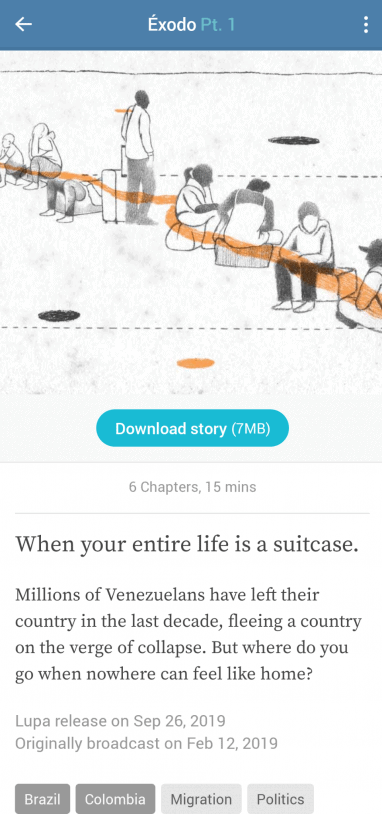
Is Lupa Right for You?
Everybody learns differently, which means Lupa will simultaneously be someone’s ideal app and disappoint someone else. So let’s take a look at who Lupa is (and isn’t) well-suited to.
First, Lupa probably isn’t the best choice for you if you want:
- Light-hearted study materials
- An all-in-one app that will train you on reading, writing, speaking, grammar, vocabulary and pronunciation in addition to listening
- Practice activities and learner pathways
- To use a screen reader
However, Lupa could be right for you if you’re happy with the price and you:
- Want to improve your listening comprehension with a variety of Latin American accents
- Would like to gain lots of cultural insights, especially into under-represented communities and cultures
- Either don’t care about memorising all the new vocabulary you come across or are willing to use Lupa alongside a flashcard-based resource
- Already have a strong base in Spanish – or relish the idea of being challenged
Lupa is a high-quality resource with a fantastic range of stories for learners to select from. Its student-friendly additional features will help you enjoy material that would normally be too challenging – although it’s focused on helping you understand the material, not remember it. And the app will really push your listening comprehension.
Lupa might not be the right tool for everyone. But for some learners, it will be an excellent choice.
Resources to Use Alongside Lupa
Since Lupa’s focused on listening comprehension, most learners will want to use it alongside other resources. Flashcard apps will help you remember the new vocabulary you come across. Anki is not the most entertaining of apps, but it’s highly customisable and uses SRS to improve your long-term recall. Or for something more interactive and gamified, create your own Memrise decks.
To put this new vocabulary into practice and make sure your speaking skills are as strong as your listening comprehension, you could also take Spanish classes. There are plenty of options for one-to-one classes online. In particular, Baselang (review) and SpanishVIP (review) both offer literally unlimited Spanish classes with Latin American teachers for a monthly fee.
You could also try Madrid-based Aprende Hablando, which has a similar model but also offers European Spanish classes. However, we haven’t a chance to try Aprende Hablando, so we can’t confirm the quality or value.
Looking for some more grammar practice but don’t want to sign up for classes? Babbel (review) is a more serious version of a gamified language app, and it’s got plenty of Spanish courses for you to choose from: beginner up to advanced, business Spanish, travel basics, Mexican Spanish, grammar, vocabulary, listening and speaking, idioms…
Alternatively, Fluencia (review) has well-structured and comprehensive beginner and intermediate-level courses with a strong focus on grammar and vocabulary.
Lupa Alternatives that will Improve Your Listening Comprehension – & More
If Lupa doesn’t sound like your cup of tea, don’t worry: there are plenty of alternative options.
A recurring comment from our testers was the difficulty of Lupa’s podcast episodes. If you like the idea of the app but want something a little less challenging, try one of these:
News in Slow Spanish (review) started life as a podcast and developed into an array of podcast-esque courses. As the name implies, even higher-level content is slowly narrated.
Spanish Uncovered (review), designed for complete beginner to lower-intermediate (B1) students, is a 20-chapter original audiobook interspersed with lots of Spanish video lessons. It’s pricey but entertaining.
Destinos (mini review) adds some drama to your studies – quite literally. This free, beginner-level video course tells the story of a lawyer investigating a family secret.
Lupa will give you almost zero practice with European Spanish. If you want to develop an ear for el acento madrileño, valenciano or gallego, give some of these a go:
News in Slow Spanish (review) has a 100% Castilian Spanish version of all its courses and podcasts. It’s well-suited to beginner and intermediate-level learners.
Lengalia (review) has courses, videos and podcasts for Castilian Spanish learners of all levels, from complete beginners upwards. It’s based on the CEFR levels, so unlike some resources, its advanced levels really can challenge C1+ learners.
iVoox is one of Spain’s most used podcasting sites and apps. Opt for some of the more popular podcasts, like La Rosa de los Vientos, Carne Cruda, La Escóbula de la Brújula or SER Historia. Or browse for something less well-known but no less interesting.
Lupa might develop your listening comprehension and introduce you to a wide range of vocabulary, but it’s not very structured. Moreover, there’s limited grammar practice. So if you’re looking for something that’s more like an audio course, try these out:
Coffee Break Spanish (review) has a huge number of well-organised podcast-esque lessons at all levels. They’re relaxed and unintimidating, and lots of the material is available for free. It primarily teaches European Spanish.
Lengalia (review) is as structured as it comes, with courses from complete beginner (A0) up to upper advanced (C2). It’s mostly focused on Castilian Spanish, but there’s also a B2-level Latin American Spanish podcast-based course with lots of accompanying exercises.
Spanish Uncovered (review) offers the best of both worlds: a 20-chapter original audiobook that grows more difficult over time; and an array of grammar, vocabulary, pronunciation and culture lessons. The only downside is the high price.
Sign up via the link below to get a discounted price.
NOTE: LUPA IS NOW JIVEWORLD. WE UNDERSTAND THE APP HAS BEEN TOTALLY REDESIGNED AND IMPROVED, BUT HAVE NOT YET HAD OPPORTUNITY TO TEST IT OUT. This review applies to the old Lupa.

